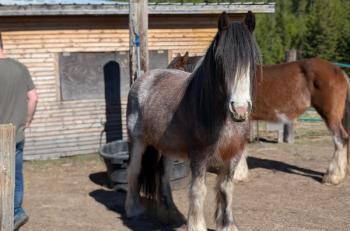
Transfixation casting (Proceedings)
The major concern of any fracture repair is to maintain adequate stability for fracture healing to occur. The stability provided by open reduction and internal fixation (ORIF) is difficult to achieve with other methods of fracture repair. However, ORIF invades the fracture site, can lead to further disruption of vasculature and soft tissue and may provide a mechanism for infection to develop or persist.
The major concern of any fracture repair is to maintain adequate stability for fracture healing to occur. The stability provided by open reduction and internal fixation (ORIF) is difficult to achieve with other methods of fracture repair. However, ORIF invades the fracture site, can lead to further disruption of vasculature and soft tissue and may provide a mechanism for infection to develop or persist. Alternative mechanisms such as external coaptation (primarily casts) and external skeletal fixation (ESF) to provide stability without invasion of the fracture site should be considered. In some instances, internal fixation can be combined with external coaptation or ESF to provide adequate stability with minimal implants at the fracture site.
Transfixation casts, a form of external fixation, are not new and reports in the literature date back to the 1950's.1 However, improvements in casting materials, transfixation pins, and a greater understanding of the mechanics of the transfixation casts have improved the stability provided by transfixation casts and have reduced the risk of complications.
The transfixation cast effectively transfers the forces of weightbearing from the bony column to the fiberglass cast.2 The transfixation cast utilizes pins placed through bones in the limb proximal to the fracture and the cast suspends the limb distal to the pins. The transfixation cast can be used as the sole method for support or in combination with methods of internal fixation such as lag screws.
Technique
The transfixation cast is technically easy to construct and consists of readily available components. Equipment required to construct a transfixation cast is limited and an extensive inventory of hardware is not required. Proper pin placement is the most important step in constructing a transfixation cast that will provide long term weightbearing. I prefer to use IMEX® Large Animal centrally threaded transfixation pinsa . This ¼ inch positive profile transfixation pin has a tap to thread the bone following predrilling with a 6.2 mm bit. The three step pin placement method reduces thermal necrosis of bone that can occur with self tapping transfixation pins, and prolongs the stability of the bone-pin interface.3 Pins should be placed as far from the top of the cast as possible so the cast does not act as a lever at the bone-pin interface. This decreases the likelihood of fracture through the bone-pin interface. For most adult horses, 2 or 3 transfixation pins are adequate. I often use 2 pins; however I have seen horses with 3 pins wear the cast well for 6 weeks. For adult horses, I use the ¼ inch pin described above; the 3/16 inch centrally threaded transfixation pin can adequately support foals. Pins should be placed through releasing incisions of adequate length so that the skin will lie smoothly around the pin. During drilling and tapping, the bit and tap should be irrigated with saline to lubricate and dissipate the heat. Placing pins divergent from the frontal plane appears to decrease the likelihood of secondary fracture through the bone-pin interface.4 It is important to insure that you do not impinge on the caudal cortex as this will significantly weaken the bone.
For phalangeal injuries, a short limb cast to the proximal third metacarpal or metatarsal (MC/MT) bone with pins through the distal MC/MT is adequate. When the transfixation pins need to be placed through the mid or proximal MC/MT or distal radius, a full limb cast is indicated. I place the cast as I would for any normal full or short limb cast. I use a double layer of stockinette, felt at the top and heel-bulb region, and a thin layer of cast padding. An assistant is needed to cut the casting tape, parallel to the roll, as you roll over the pins. Cutting the material allows it to lie smoothly against the limb. When an adequate amount of fiberglass is applied, cut the pins nearly flush with the cast. The ends of the pins can be covered with either another roll of fiberglass cast material or with acrylic (Techovit)b.
Complications
The transfixation cast is not the answer for dealing with all fracture configurations and the practitioner should consider the complications associated with its use prior to application. The primary complication of transfixation casting is premature loosening of the transfixation pins. Loosening of the pins is detected by an increased lameness in the transfixed limb and radiographic evidence of osteolysis at the bone-pin interface. Pin loosening can occur as a result of improper pin placement technique that causes thermal necrosis and microfractures and subsequent osteolysis. Pin loosening allows for establishment of infection at the bone-pin interface that increases the osteolysis around the transfixation pin. The most severe complication of transfixation casting is secondary fracture through the bone-pin interface. This can be limited by utilizing the smallest diameter pins capable of withstanding the weight of the horse, divergent pin placement, and by maximizing the distance between the pins and the top of the cast.
Transfixation casting is not the answer to all complicated distal limb fractures, but it can provide an alternative method for stabilizing distal limb fractures.
References
Reichel EC: Treatment of fractures of the long bones in large animals. J Am Vet Med Assoc 1956; 103:8-15.
McClure SR, Watkins JP, Ashman RB: An in vitro comparison of the standard short limb cast and three configurations of short limb transfixation casts. Am J Vet Res 1994; 55:1331-1334.
Morisset.
McClure SR, Watkins JP, Ashman RB. An in vitro comparison of the effect of parallel and divergent transfixation pins on the breaking strength of the equine third metacarpal bone. Am J Vet Res 1994; 55:1327-1330.
Footnotes
aImex Inc., 1227 Market Street, Longview, TX 75604.
bJorgensen Laboratory Inc., 1450 North Van Buren Ave, Loveland, CO 80538.
Evaluation of transfixation casting for treatment of third metacarpal, third metatarsal, and phalangeal fractures in horses: 37 cases (1994–2004)
Timothy B. Lescun, BVSc, MS, DACVS; Scott R. McClure, DVM, PhD, DACVS; Michael P. Ward, BVSc, PhD; Christopher Downs, DVM; David A. Wilson, DVM, MS, DACVS; Stephen B. Adams, DVM, MS, DACVS; Jan F. Hawkins, DVM, DACVS; Eric L. Reinertson, DVM, MS
Department of Veterinary Clinical Sciences, School of Veterinary Medicine, Purdue University, West Lafayette, IN 47907-1248 (Lescun, Adams, Hawkins); Department of Veterinary Clinical Sciences, College of Veterinary Medicine, Iowa State University, Ames, IA 50011-1250 (McClure, Reinertson); Department of Veterinary Integrated Biosciences, College of Veterinary Medicine and Biomedical Sciences, Texas A&M University, College Station, TX 77843-4461 (Ward); Department of Veterinary Medicine and Surgery, College of Veterinary Medicine, University of Missouri, Columbia, MO 65211 (Downs, Wilson)
Objective—To evaluate clinical findings, complications, and outcome of horses and foals with third metacarpal, third metatarsal, or phalangeal fractures that were treated with transfixation casting.
Design—Retrospective case series.
Animals—29 adult horses and 8 foals with fractures of the third metacarpal or metatarsal bone or the proximal or middle phalanx.
Procedures—Medical records were reviewed, and follow-up information was obtained. Data were analyzed by use of logistic regression models for survival, fracture healing, return to intended use, pin loosening, pin hole lysis, and complications associated with pins.
Results—In 27 of 35 (77%) horses, the fracture healed and the horse survived, including 10 of 15 third metacarpal or metatarsal bone fractures, 11 of 12 proximal phalanx fractures, and 6 of 8 middle phalanx fractures. Four adult horses sustained a fracture through a pin hole. One horse sustained a pathologic unicortical fracture secondary to a pin hole infec-tion. Increasing body weight, fracture involving 2 joints, nondiaphyseal fracture location, and increasing duration until radiographic union were associated with horses not returning to their intended use. After adjusting for body weight, pin loosening was associated with di-aphyseal pin location, pin hole lysis was associated with number of days with a transfixation cast, and pin complications were associated with hand insertion of pins.
Conclusions and Clinical Relevance—Results indicated that transfixation casting can be successful in managing fractures distal to the carpus or tarsus in horses. This technique is most suitable for comminuted fractures of the proximal phalanx but can be used for third metacarpal, third metatarsal, or middle phalanx fractures, with or without internal fixation.
Newsletter
From exam room tips to practice management insights, get trusted veterinary news delivered straight to your inbox—subscribe to dvm360.






